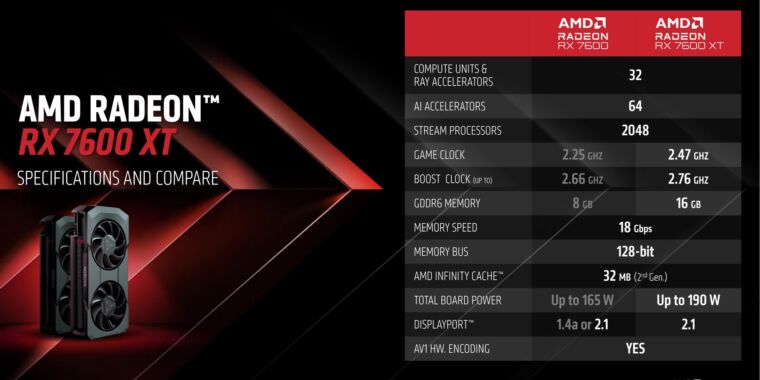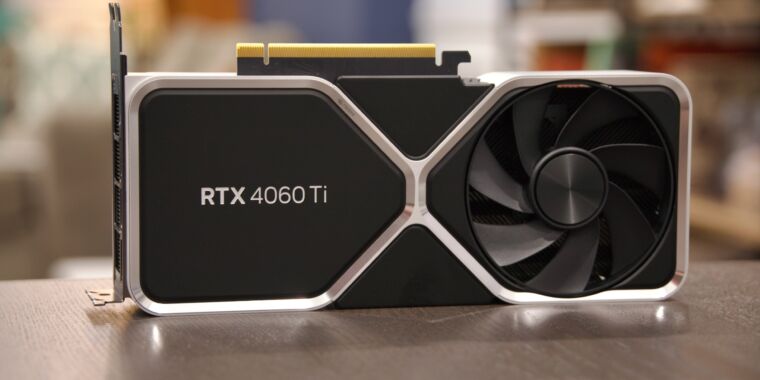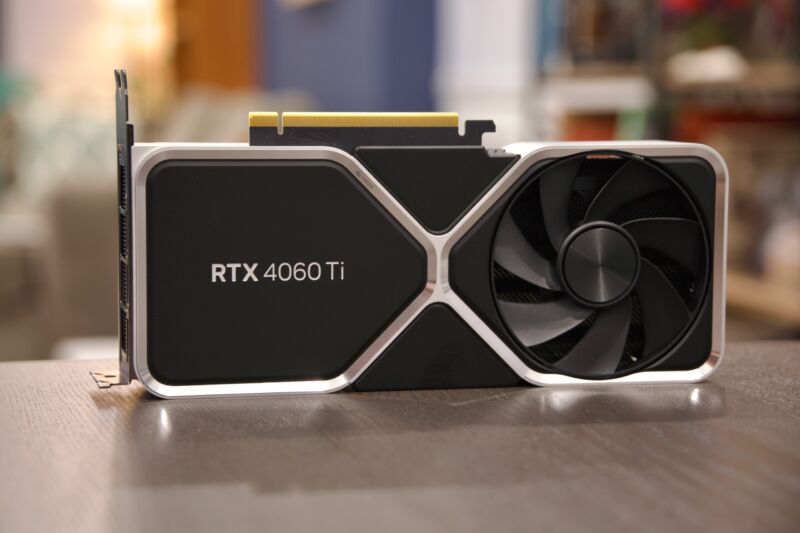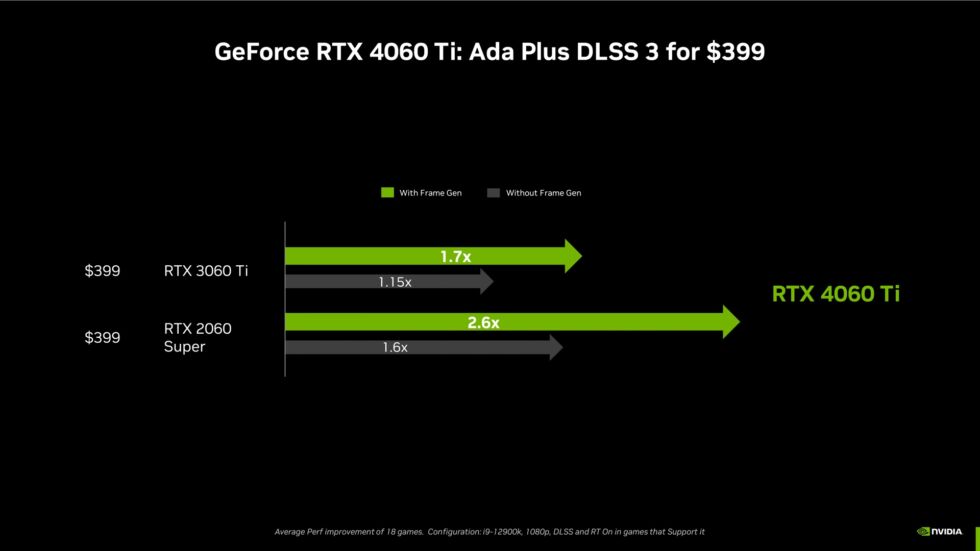$329 Radeon 7600 XT brings 16GB of memory to AMD’s latest midrange GPU
more rams —
Updated 7600 XT also bumps up clock speeds and power requirements.
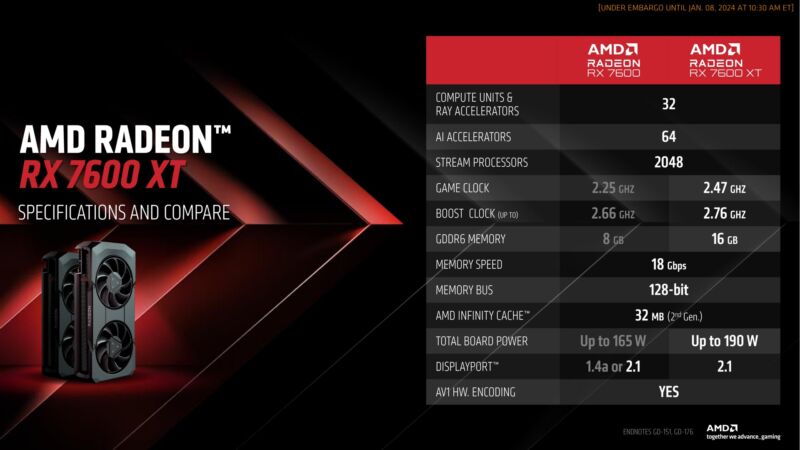
Enlarge / The new Radeon RX 7600 XT mostly just adds extra memory, though clock speeds and power requirements have also increased somewhat.
AMD
Graphics card buyers seem anxious about buying a GPU with enough memory installed, even in midrange graphics cards that aren’t otherwise equipped to play games at super-high resolutions. And while this anxiety tends to be a bit overblown—lots of first- and third-party testing of cards like the GeForce 4060 Ti shows that just a handful of games benefit when all you do is boost GPU memory from 8GB to 16GB—there’s still a market for less-expensive GPUs with big pools of memory, whether you’re playing games that need it or running compute tasks that benefit from it.
That’s the apparent impetus behind AMD’s sole GPU announcement from its slate of CES news today: the $329 Radeon RX 7600 XT, a version of last year’s $269 RX 7600 with twice as much memory, slightly higher clock speeds, and higher power use to go with it.
| RX 7700 XT | RX 7600 | RX 7600 XT | RX 6600 | RX 6600 XT | RX 6650 XT | RX 6750 XT | |
|---|---|---|---|---|---|---|---|
| Compute units (Stream processors) | 54 (3,456) | 32 (2,048) | 32 (2,048) | 28 (1,792) | 32 (2,048) | 32 (2,048) | 40 (2,560) |
| Boost Clock | 2,544 MHz | 2,600 MHz | 2,760 MHz | 2,490 MHz | 2,589 MHz | 2,635 MHz | 2,600 MHz |
| Memory Bus Width | 192-bit | 128-bit | 128-bit | 128-bit | 128-bit | 128-bit | 192-bit |
| Memory Clock | 2,250 MHz | 2,250 MHz | 2,250 MHz | 1,750 MHz | 2,000 MHz | 2,190 MHz | 2,250 MHz |
| Memory size | 12GB GDDR6 | 8GB GDDR6 | 16GB GDDR6 | 8GB GDDR6 | 8GB GDDR6 | 8GB GDDR6 | 12GB GDDR6 |
| Total board power (TBP) | 245 W | 165 W | 190 W | 132 W | 160 W | 180 W | 250 W |
The core specifications of the 7600 XT remain the same as the regular 7600: 32 of AMD’s compute units (CUs) based on the RDNA3 GPU architecture and the same memory clock speed attached to the same 128-bit memory bus. But RAM has been boosted from 8GB to 16GB, and the GPU’s clock speeds have been boosted a little, ensuring that the card runs games a little faster than the regular 7600, even in games that don’t care about the extra memory.
Images of AMD’s reference design show a slightly larger card than the regular 7600, with a second 8-pin power connector to provide the extra power (total board power increases from 165 W to 190 W). The only other difference between the cards is DisplayPort 2.1 support—it was optional in the regular RX 7600, but all 7600 XTs will have it. That brings it in line with all the other RX 7000-series GPUs.
-
AMD’s hand-picked benchmarks generally show a mild performance improvement over the RX 7600, though Forza is an outlier.
AMD
-
The 7600 XT’s performance relative to Nvidia’s RTX 4060 is also a little better than the RX 7600’s, thanks to added RAM and higher clocks. But Nvidia should continue to benefit from superior ray-tracing performance in a lot of games.
AMD
-
Testing against the 4060 at 1440p. Note that the longest bars are coming from games with FSR 3 frame-generation enabled and that Nvidia’s cards also support DLSS 3.
AMD
-
The complete RX 7000-series lineup.
AMD
AMD’s provided performance figures show the 7600 XT outrunning the regular 7600 by between 5 and 10 percent in most titles, with one—Forza Horizon 5 with ray-tracing turned all the way up—showing a more significant jump of around 40 percent at 1080p and 1440p. Whether that kind of performance jump is worth the extra $60 depends on the games you play and how worried you are about the system requirements in future games.
AMD says the RX 7600 XT will be available starting on January 24. Pricing and availability for other RX 7000-series GPUs, including the regular RX 7600, aren’t changing.
$329 Radeon 7600 XT brings 16GB of memory to AMD’s latest midrange GPU Read More »
